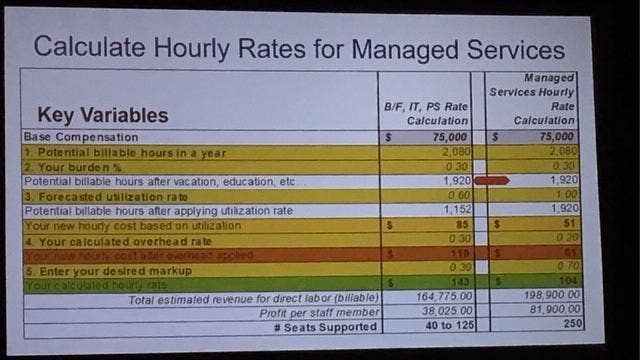Keys To MSP Profits: Understanding Costs And The Power Of Bundling

Correctly pricing an MSP’s services starts with a clear knowledge of the MSP business’ fundamental costs, according to Len DiCostanzo, head of his own private consulting firm MSP Tools.
DiCostanzo, speaking to an audience of MSPs at this week's NexGen 2018 Conference and Expo in Anaheim, Calif., also said that a key way to charge customers for services rendered is to bundle those services together in packages that are both easier to sell and easier to buy.
Determining a fair and reasonable rate at which to bill clients for their services requires first knowing clearly what the cost of labor is for providing those services, DiCostanzo said.
[Related: MSP Toolkit: What Solution Providers Need To Do To Keep Customers For Life]
There are several variables that go into determining the labor rate for break-fix, IT, and professional services.
The first, he said, is the potential billable hours in a year, which is easy to estimate by multiplying 260, the average number of working days in a year, by the number of working hours in a day. That works out to 2,080 potential billable hours in a year.
However, with vacation, sick leave, and other benefits, MSPs will have to subtract a certain amount of time, which DiCostanzo called the MSP's "burden." He said it may be reasonable for an MSP to subtract a burden of 30 percent, leaving 1,920 billable hours in the example he presented at NexGen.
MSPs also have to forecast a reasonable utilization rate, or the amount of a technician's time he or she will actually be able to spend on working with clients. In his example, he assumed a forecasted utilization rate of 60 percent, leaving 1,152 potential billable hours.
Dividing the technician's base compensation, which in his example was $75,000 per year, by the 1,152 potential billable hours gives an hourly cost of $85. However, that number does not include the cost of overhead MSP owners incur such as rent, power, and so on. In his example, he assumed overhead of 30 percent, which when added to the cost of the technician resulted in an actual cost of $110 per hour.
MSPs can then add their desired markup, which in DiCostanzo's example was 30 percent, giving him a final hourly rate of $143 per hour to use for quoting customer services.

The calculation changes when looking at the labor rate for managed services, DiCostanzo said.
Instead of a utilization rate of 30 percent, a managed services technician may have a utilization rate of 100 percent since he or she will be working remotely instead of traveling to the customer's site. He also said the overhead in such a case can be smaller, in his example at 20 percent instead of 30 percent.
However, given the lower overhead costs, MSPs can actually raise the markup for the services, DiCostanzo said. In his example, even with the higher markup, the per-hour labor rate was only $104.
More importantly, given the fact that the typical technician might be able to support 40 to 125 seats, a managed services technician may be able to support 250 seats, DiCostanzo said.
Bundling services is also a good way to provide fairly-priced services to MSP clients in that they make it clear to clients what they can expect and makes it easier to retain their patronage, DiCostanzo said.
"You don't want to give customers a huge list and let them pick and choose," he said. "You want to tell customers what services you want to offer."
Ideally, an MSP will offer a choice of three bundles, DiCostanzo said. "Customers often go with the middle bundle, and often go with the higher-priced bundle," he said.
In any event, MSPs should not break up a bundle unless they have an opportunity to add on additional services, he said.
DiCostanzo cited as an example of a bundled managed service one that turns physical desktops into a service. He said such as service could include asset management, policy management, application management, patch management, security, scheduled maintenance, and hot swap.
"The point is, you go from a device-based billing to a services-based billing. … think about charging per user, or add a department-based component," he said.
Dave Seibert, chief information officer at IT Innovators, an Irvine, Calif.-based MSP, said he agreed with DiCostanzo that the key to success is to structure one's business and know the numbers.
"When you don't know the numbers, it's hard to run your business," Seibert told CRN. "You have to lay out the costs. Otherwise, you don't know what to sell at. Partners need to do this, but a lot don't."
Bundling of services and automation are also a winning ticket for MSPs, Seibert said. "A lot of people are still not doing it," he said. "But it really is a requirement."